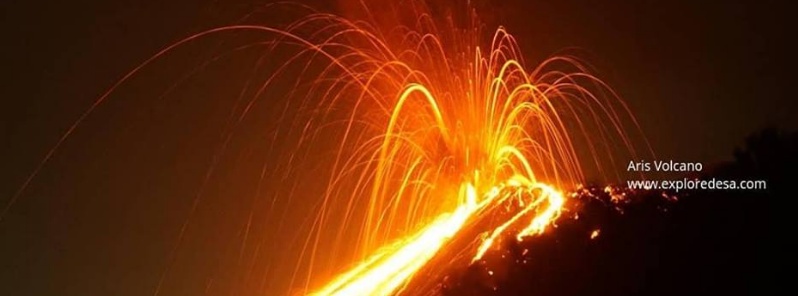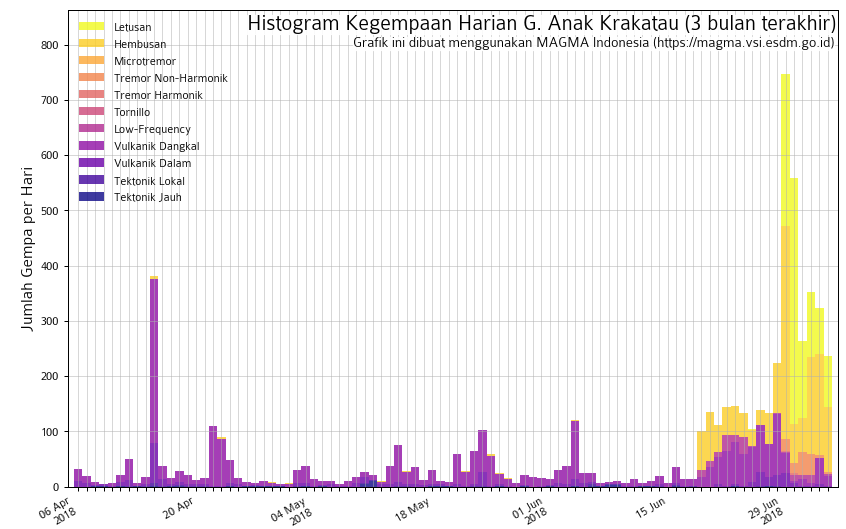Increased eruptive activity at Anak Krakatau volcano, Indonesia

Anak Krakatau, or Child of Krakatau, is showing signs of increased activity and it seems the eruption has reached a phase of being more or less continuous, the Volcano Discovery reports.
Krakatau, located between the Indonesian islands of Java and Sumatra, started erupting on June 19, 2018 with ash column rising just a few hundred meters before it dissipated. However, satellite imagery showed an increase in thermal radiation since March 2018, suggesting that magma is approaching the surface.

Thanks to Volcano Discovery and their friends at Anak Krakatau Volcano Observatory, we now have confirmation that lava flow is emerging from the summit area, which is in line with a moderately strong thermal signal detected via satellites.
Observers near the volcano report frequent explosions that generate ash plumes that rise few hundreds of meters as well as glow from the summit area.
Satellite (Sentinel-2) images of #Krakatau volcano of 19th June. Anak-krakatau, the volcanic-cone in the middle, seems to be emitting a small grey plume from the summit-crater, drifting West. pic.twitter.com/0f57T63K8j
— Øystein L. Andersen (@OysteinLAnderse) June 21, 2018
Multiple hotspots detected by MODIS imagery at #Krakatau volcano on the 30th June. pic.twitter.com/CiDG2JLmtQ
— Øystein L. Andersen (@OysteinLAnderse) July 2, 2018
The last Volcano Observatory Notice for Aviation (VONA) for Anak Krakatau was issued 09:59 UTC on July 5.
The eruption lasted for 30 seconds, producing a column of ash that rose up to 605 m (1 936 feet) or higher than could be observed clearly. Ash cloud was moving to the northwest.
The Aviation Color Code remains Orange.
If you are interested, Volcano Discovery is organizing an expedition to study and observe Anak Krakatau volcano and its activity. The next expedition is planned for July 12 – 14.
Geological summary
The renowned volcano Krakatau (frequently misstated as Krakatoa) lies in the Sunda Strait between Java and Sumatra. The collapse of the ancestral Krakatau edifice, perhaps in 416 CE, formed a 7-km-wide (4.3 miles) caldera.
Remnants of this ancestral volcano are preserved in Verlaten and Lang Islands; subsequently Rakata, Danan and Perbuwatan volcanoes were formed, coalescing to create the pre-1883 Krakatau Island. Caldera collapse during the catastrophic 1883 eruption destroyed Danan and Perbuwatan volcanoes, and left only a remnant of Rakata volcano.
This eruption, the 2nd largest in Indonesia during historical time, caused more than 36 000 fatalities, most as a result of devastating tsunamis that swept the adjacent coastlines of Sumatra and Java. Pyroclastic surges traveled 40 km (25 miles) across the Sunda Strait and reached the Sumatra coast.
After a quiescence of less than a half century, the post-collapse cone of Anak Krakatau (Child of Krakatau) was constructed within the 1883 caldera at a point between the former cones of Danan and Perbuwatan. Anak Krakatau has been the site of frequent eruptions since 1927. (GVP)
Featured image: Eruption of Anak Krakatau at 21:05 local time on July 3, 2018. Credit: Aris Yanto

Commenting rules and guidelines
We value the thoughts and opinions of our readers and welcome healthy discussions on our website. In order to maintain a respectful and positive community, we ask that all commenters follow these rules:
We reserve the right to remove any comments that violate these rules. By commenting on our website, you agree to abide by these guidelines. Thank you for helping to create a positive and welcoming environment for all.